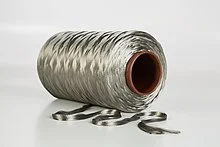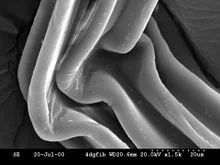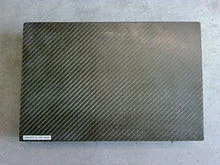Fiber Definition
Fiber
is a natural or man-made material that is significantly longer than it is wide.
Fibers are often used to make other materials. Strong engineering elements
often attach fibers, for example, carbon fiber and ultra-high-molecular-weight
polyethylene.
Textile
Fiber
Textile
Fiber is a fiber that has some special characteristics such as staple length,
spun length, fineness, strength, twisting capacity, etc. are called Textile
fiber. Banana fiber is a fiber but not textile fiber because not fulfill that
characteristic.
Different
types of Textile Fibres are below-
1.
Animal Fibre: The fiber which we get from an animal such as sheep, or a goat
is called animal fiber. Animal fibers are commonly made from hair, fur, skin,
or silk (in the silkworms’ case). Examples- Wool, Silk, etc.
a.Wool
fiber: Wool refers to the hair of the domestic sheep or goat, which is
distinguished from other types of animal hair in that the individual strands
are coated with scales and tightly crimped, and the wool as a whole is coated
with a wax mixture named lanolin, which is waterproof and dirt proof. Woolen
refers to a bulkier yarn produced from carded, non-parallel fiber, while
worsted refers to a finer yarn spun from longer fibers that have been combed to
be parallel. Wool is commonly used for warm clothing. In Cashmere, Indian
Cashmere goat hair, and North African Angora goat hair Mohair are a type of
wool is known for its softness.
 |
| Wool Fibre |
Other
animal fibers made from hair or wool are alpaca wool, vicuna wool, llama wool, and camel hair, commonly used in the production of coats, jackets, ponchos,
blankets, and other warm covers. Angora refers to the long, thick, soft hair of an
Angora rabbit. Qiviut is the fine inner wool of the muskox. Wadmal is a thick cloth
made of wool, produced in Scandinavia, often 1000 ~ 1500 CE.
b.
Silk fiber: Silk
is an animal fiber made from the fibers of the cocoon of the Chinese silkworm
which is spun into a smooth fabric prized for its softness. There are two main
types of silk: 'mulberry silk' produced by the Bombyx Mori, and 'wild silk'
such as Tussah silk (wild silk).
When
cultivated in habitats with fresh mulberry leaves for consumption, silkworm
larvae produce the first type, and the tussah silk silkworm is produced by
feeding on oak leaves. About a quarter of the world's silk production is made
up of agricultural silk. Sea silk is a very delicate, rare, and precious fabric
that is hidden from the silky filament or byssus by the foot glands of the pen
shell.
2.
Plant fiber: The
fibers which are we get from different types of trees are called plant fiber.
Examples: Cotton, flax, jute, hemp, sisal, etc.
a. Cotton
fiber: Cotton
is a flexible, fluffy staple fiber that grows in a ball or protective fields,
around the seeds of the cotton plant of the genus Gossypium in the Mallow
family Malvaceae. The fiber is almost pure cellulose. Under natural conditions,
cotton balls will scatter the seeds.
 |
| Cotton Fibre |
The plant is a shrub native to tropical and subtropical regions of the world,
including the United States, Africa, Egypt, and India. The largest variety of
wild cotton species is found in Mexico that is followed by Australia and
Africa. Cotton was raised independently in the old and new worlds.
The current estimate of world production is about 25 million tons or 110 million
bales per year, which is 2.5% of the world's arable land. India is the world's
largest cotton producer and the United States has been the largest exporter for
many years. In the United States, cotton is usually measured with bales that
weigh about 0.48 cubic meters and weigh 226.8 kilograms.
b.
Jute fiber: Jute
is a long, soft, shiny bust fiber that can be cut into thick, strong threads.
It is originally produced from a plant of the genus Corchorus, which was once
classified with the Tiliaceae family. The primary source of fiber is the
Corchorus olitorius, but it is thought to be inferior to the Corchorus
capsularis. Jute is the plant fiber that is used to make burlap, hessian or
gunny cloth.
Jute
is one of the most affordable natural fibers, and second only to cotton in
quantity and variety used. Jute fibers are mainly composed of plant materials
cellulose and lignin. It falls into the category of bast fiber collected from
bust fiber plants with kenaf, industrial horn, flax (linen), rummy, etc., The
industrial term for jute fiber is raw jute fibers are white-brown and 1-4 m
tall. Jute is also called golden fiber for its color and high cash quality.
Jute
plants require simple alluvial soil and standing water. The climate is suitable for
growing jute (warm and wet) is presented during the rainy season by the monsoon
climate. Temperature 20˚C to 40˚C and relative humidity 70% to 80% Optimal
Cultivation for successful cultivation Jute requires 5-6 cm weekly rainfall at
the time of sowing and more. Soft water is required for jute production.
c.
Hemp fiber: Hemp
is a variety of cannabis Sativa plant species that are grown specifically for
the industrial use of its products. It is one of the fastest-growing plants and
it was one of the first plants cut into usable fibers 50,000 years ago. It can
be modified into various commercial items including paper, textiles, clothing,
biodegradable plastics, paints, insulation, biofuels, food, and animal feed.
Although
both cannabis and industrial hemp as drugs originate from the cannabis Sativa
species and contain the psychoactive ingredient tetrahydrocannabinol (THC),
they have different strains with different phytochemical compositions and uses.
Hemp has a lower concentration of THC and a higher concentration of cannabidiol
(CBD), which reduces or eliminates its psychological effects. The legitimacy of
industrial horns varies greatly between countries. Some governments control the
concentration of THC and only allow hemp that is bred with a particularly low
THC content.
d.
Sisal fiber: Sisal
is a species of Agave sisalana in South America with the botanical name but is
widely cultivated and naturalized in many other countries. It gives a solid
fiber yield used in making various products. The term sisal can refer to the
common name or fiber of a plant, depending on the context. It is sometimes
referred to as sisal hemp because hemp has been the main source of fiber for
centuries and other fiber sources have been named after it.
Sisal
fiber is generally used for rope and yarn and has many more uses including
paper, cloth, footwear, hats, bags, carpets, geotextiles, and dartboards. It is
used as a fiber reinforcement for composite fiberglass, rubber, and cement
products.
3.
Mineral fiber: Used
for asbestos and basalt fiber vinyl tiles, sheeting and adhesive, transit
panels and siding, acoustic ceilings, stage curtains, and fire blankets.
a.
Glass fiber: It
is used in the manufacture of an ironing board and mattress cover, rope and
cables, composite materials, insect nets, flame-retardant, and protective
fabric, and soundproof, fireproof, and insulating fibers. Glass fibers are
woven and coated with Teflon to make beta fabrics, a virtual fireproof fabric
that replaces nylon on the outer layer of the U.S. space suite since 1968.
b.
Metallic fiber: Metal
fibers are fibers made of metal, metal alloys, plastic-coated metals, fibers
made with a core completely covered by metallic-coated plastic or metal. As a
source of textile and garment applications, gold and silver fibers have been
used as yarn for fabric decoration since ancient times. Most recently, aluminum
yarn, aluminized plastic yarn, and aluminized nylon yarns have been replaced by
gold and silver.
 |
| Metallic Fibre |
Today's metallic fiber industry mainly supplies fiber in stainless steel, nickel,
titanium, copper, and aluminum for various applications. Metal filaments can be
coated with a transparent film to reduce damage. Metal fibers can also be shaved
from wire (steel wool), shaved from foil, bundles are drawn from a wire of large
diameter, mixed from a knot, cast from molten metal, or grown around a seed
(usually carbon). There is a wide variety of uses for metal fibers, metal foil, and metal wire, including the manufacture of gold fabrics and jewelry. Hardware
cloth (US term only) is a thick woven mesh of steel wire, which is used in
construction. It's a lot like standard window screening but heavier and more
open-weaved.
c.
Minerals and natural: Minerals
and natural and synthetic fabrics can be mixed Like emery fabrics, a layer of
emery abrasive sticks to the back of the fabric. Also, the American term sand
cloth is a fine wire mesh that is used as emery cloth or coarse sandpaper.
4. Synthetic
fiber: The fiber we make from different types of chemicals like polyester, acrylic, and
nylon is called synthetic fiber. Synthetic fibers are primarily used in garment
manufacturing, as well as in making geotextiles.
a.
Polyester: Polyester
is a division of polymers that contains the ester functional group in their
main chain. As a specific ingredient, it refers to a type called polyethylene
terephthalate (PET). Polyesters include naturally occurring chemicals such as
tree cuttings, as well as synthetics such as polybutyrate. Natural polyesters
and a few synthetics are biodegradable, but most synthetic polyesters are not.
Material clothing is widely used.
 |
| Polyester Fibre |
Polyester
fibers are sometimes cut together with natural fibers to form a fabric with
blended properties. Cotton-polyester blends can be strong, wrinkle, and
tear-resistant and reduce shrinkage. Synthetic fibers using polyester have
higher water, wind, and environmental resistance than plant-derived fibers.
These are less fire-resistant and can melt when ignited. Polyester blends have
been renamed to suggest their similarity or even superiority with natural
fibers. Liquid crystal polyester is one of the first liquid crystal polymers
used in the industry. These are used for their mechanical properties and heat resistance. These properties are important in their application as corrosive seals in jet engines.
b.
Nylon: The fiber used in imitation of nylon silk; is also used in the manufacture of
pantyhose. Thick nylon fibers are used in rope and outdoor clothing. Nylon is a
generic title for a family of man-made polymers based on aliphatic or
semi-perfumed polyamides. Nylon is a thermoplastic silky material that can be
melted-processed into fibers, films, or shapes. It is composed of repeating
units linked by amide links similar to the peptide bonds of proteins. Nylon
polymers can be mixed with a variety of additives to achieve a wide variety of
properties. Nylon polymers have found significant commercial applications in
fabrics and fibers (reinforcement of clothing, flooring, and rubber), in shapes
(molded parts for cars, electrical equipment, etc.), and in films (for most
food packaging).
Nylon
was first commercially used on nylon-bristled toothbrushes in 1938, followed
more popularly by women's stockings or nylon, which appeared at the New York World's
Fair in 1939 and was first commercially sold in 1940. During World War II,
almost all nylon production was a parachute, and the army was diverted to use
parachute cords. The use of nylon and other plastics during the war greatly
increased the market for new materials.
c.
Aramid: Aramid
fibers are heat-resistant and strong synthetic fibers. They are used in space
and military applications for ballistic-rated body arm fabrics and ballistic
composites, marine cordage, marine whole reinforcement, and asbestos alternatives.
The chain molecules in a Portmanteau fiber of the name aromatic polyamide are
highly illuminated along the axis of the fiber. As a result, a higher ratio of
chemical bonds contributes more to fiber strength than many other synthetic
fibers. It has a very high melting point (> 500 °C).
d. Acrylic: Acrylic
is a fiber used to imitate wool, including cashmere, and is often used in
substitution. Acrylic fibers are synthetic fibers from a polymer
(polyacrylonitrile) with an average weight of about 1, 00000, and about 1900
monomer units on average. In the United States, a fiber can be called acrylic,
the polymer must contain at least 85% acrylonitrile monomer. Common comonomers
are vinyl acetate or methyl acrylate. DuPont made the first acrylic fibers in
1941 and trademarked them under the name Orlon. It was first developed in the
mid-1940s but was not mass-produced until the 1950s. Strong and warm, acrylic
fiber is often used for sweaters and tracksuits and for lining boots and
gloves, as well as in fabrics and carpets. It is produced as a filament, then
cut into short major lengths like wool hair and cut with yarn.
Modacrylic
is a modified acrylic fiber that contains a minimum of 35% and a maximum of 85%
acrylonitrile monomer. The commoner used in modacrylic is vinyl chloride,
vinylidene chloride, or vinyl bromide fiber flame retardant properties.
Modacrylic end-uses include fax wool, wigs, hair extensions, and protective
clothing.
e.
Spandex: Spandex,
Lycra, or elastane is a synthetic fiber that is known for its exceptional
elasticity. It is a polyether-polyurea copolymer that was discovered in 1958 by
chemist Joseph Shiver at DuPont’s Benger Laboratory in Waynesboro, Virginia.
Spandex is a polyurethane product that can be tightly fitted without
obstruction. It is used to produce activewear, bras, and swimsuits.
f. Olefin: Olefin
fiber is a synthetic fiber made from polyolefins, such as polypropylene or
polyethylene. The official definition of olefin fiber by the Federal Trade commission is manufactured fiber where the fiber is made of a long-chain synthetic polymer that is made up of at least 85% by weight of ethylene,
propylene, or other olefin units and Car interior. The advantages of olefin
fibers are their strength, colorlessness, comfort, staining, tearing,
abrasion, and resistance to sunlight, and their good bulk and cover. Olefin fiber
is a fiber used in activewear, lining, and warm clothing. Olefins are
hydrophobic, allowing them to dry quickly. A soothing feeling of olefin fibers
is sold under the name Tyvek.
g. Milk fiber: Milk
proteins have also been used to make synthetic fabrics. Milk or casein fiber
cloth was further developed in Germany during the First World War and in Italy
and America in the 1930s. Milk fiber fabric is not very durable and easily
wrinkles but it has the same pH as human skin and has anti-bacterial
properties. It is marketed as a biodegradable, renewable synthetic fiber.
h.
Carbon fiber: It
is used in most blended materials, such as carbon fiber-reinforced plastics
together with resin. Fibers are made from polymer fibers through carbonization.
Carbon fibers are used to fabricate microelectrodes of carbon fiber. In this
application, a single carbon fiber 5-7 mm in diameter is usually sealed in a
glass capillary. At the tip, the capillary is either sealed with epoxy, and a
carbon-fiber disc is made to form the microelectrode, or the fiber is cut to a
length of 75-150 mm to form the carbon-fiber cylinder electrode. Carbon-fiber
microelectrodes are used in amperometry or fast-scan cyclic voltmeters for
biochemical signal detection.
 |
| Carbon Fibre |














0 Comments